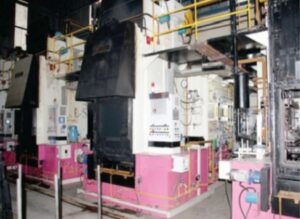A sealed quench furnace is a type of heat treatment furnace designed to perform processes like hardening, tempering, annealing, and carburizing under a controlled atmosphere to prevent oxidation or decarburization of the metal. It is widely used in industries for processing steel components such as gears, shafts, and bearings. Here’s a breakdown of its operation and features:
 Key Components of a Sealed Quench Furnace
Key Components of a Sealed Quench Furnace
- Sealed Chamber: The furnace has an airtight chamber that maintains a controlled atmosphere, typically using gases like nitrogen, hydrogen, or endothermic gas to create the desired environment.
- Loading Chamber: A separate area for loading components before they are moved into the heating chamber.
- Heating Chamber: The main area where heat treatment takes place, with precise temperature and atmosphere control.
- Quenching Chamber: Connected to the heating chamber, this section rapidly cools the workpiece using oil, water, or polymer quenchants to achieve the desired hardness and microstructure.
- Recirculation Fan: Ensures uniform temperature and gas distribution in the chamber.
- Cooling Systems: Air or water-cooling mechanisms maintain the furnace’s operational stability.
- Automation Controls: Modern furnaces have PLCs (Programmable Logic Controllers) for precise control of temperature, atmosphere, and process timing.
Heat Treatment Processes in Sealed Quench Furnaces
- Carburizing:
- Involves introducing carbon into the surface of low-carbon steel to enhance surface hardness while retaining a tough core.
- Achieved by maintaining a carbon-rich atmosphere in the heating chamber at temperatures of 850–950°C.
- Carbonitriding:
- Similar to carburizing but with the addition of nitrogen to the process, improving wear resistance and hardness.
- Annealing:
- Used to relieve stresses, improve machinability, and refine the microstructure of the metal by slowly cooling it in a controlled atmosphere.
- Hardening and Quenching:
- Heat the metal to its austenitizing temperature, then quench it rapidly in oil or another quenchant to achieve a hard microstructure.
- Tempering:
- Performed after quenching to reduce brittleness and adjust the mechanical properties.
Advantages of Sealed Quench Furnaces
- Atmosphere Control: Prevents oxidation, scaling, and decarburization.
- Uniform Heating: Recirculation fans ensure even temperature distribution, leading to consistent quality.
- Versatility: Supports a range of heat treatment processes for different materials.
- Energy Efficiency: Well-insulated chambers minimize energy losses.
- Environmentally Friendly: Reduces emissions and heat loss compared to open furnaces.
Feel free to contact us if you would you like to know more details.


